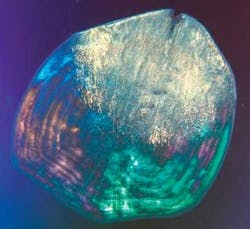Photonic crystals in the skin of fish may enhance a fish’s light-reflecting properties, according to researchers from the Weizmann Institute of Science and Hebrew University Faculty of Agriculture (both in Rehovot, Israel), and the Technion (Haifa, Israel). To experimentally reach this conclusion, biogenic organic crystals of guanine from the skin of Japanese koi fish and red-eye tetra fish were compared to synthetic crystals of commercially available anhydrous guanine. Scanning-electron-microscope images of the isolated fish crystals showed exceptionally thin (approximately 50 nm), elongated, semihexagonal plate-like forms, while the synthetic crystals were irregularly stepped and much thicker than the biogenic crystals.
It was also determined that unlike the characteristic synthetic growth morphology of guanine crystals elongated along their short crystal axis, the biogenic guanine crystals in fish are strongly inhibited along this direction of natural crystal growth for unknown reasons. The reflective property of fish thus results from this unexpected morphology and the layering of high-refractive-index guanine crystals and low-refractive-index cytoplasm layers. Somehow, fish invest energy in a biomineralization process that favors high reflectivity. Contact Lia Addadi at [email protected].
